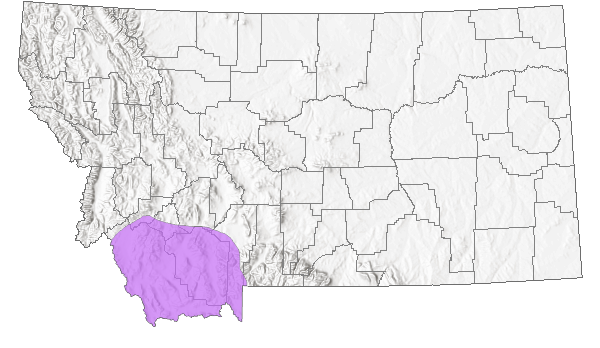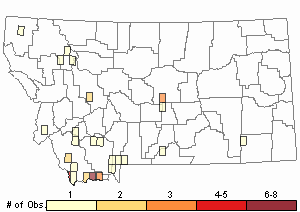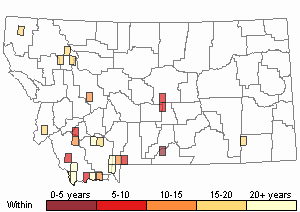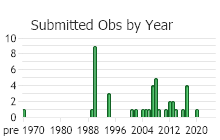View in other NatureServe Network Field Guides
NatureServe
Montana
Utah
Wyoming
Idaho
Wisconsin
British Columbia
South Carolina
Yukon
California
New York
Sitka Columbine - Aquilegia formosa
State Rank Reason (see State Rank above)
Known from several areas in southwest Montana. However, only four of these are large, high quality populations. Effects of human disturbance, such as logging, on the species are uncertain.
- Details on Status Ranking and Review
Population Size
Score2-3 - Very Small to Small: Population size is imprecisely known but is believed to be <10,000 individuals.
Range Extent
Score2 - Regional or State Endemic or Small Montana Range: Generally restricted to an area <100,000 sq. miles (equivalent to 2/3 the size of Montana or less) or Montana contributes 50% or more of the species’ range or populations OR limited to 2-3 Sub-basins in Montana.
Area of Occupancy
Score2 - Low: Generally occurring in 4-10 Subwatersheds (6th Code HUC’s).
Environmental Specificity
Score1 - Moderate: Species is restricted to a specific habitat that is more widely distributed or to several restricted habitats and is typically dependent upon relatively unaltered, good-quality habitat (C Values of 5-7).
Trends
ScoreNA - Rank factor not assessed.
CommentTrends data are lacking though likely stable to only minor declines in the recent past.
Threats
Score0-1 - Low to Medium.
CommentPotential threats appear to be minimal in magnitude or immediacy.
Intrinsic Vulnerability
Score0-1 - Low to Moderate Vulnerability.
Raw Conservation Status Score
Score
7 to 10 total points scored out of a possible 16 (Rarity factors and threats only).
General Description
Sitka Columbine is an herbaceous perennial with stems 1-6 dm high that arise from a simple or branched rootcrown. The basal leaves have long petioles and are twice divided into threes; the ultimate wedge-shaped segments are lobed and 1-5 cm long. The few, alternate stem leaves are smaller and less divided. Foliage is glabrous to sparsely hairy with a thin, waxy coating on the undersides of the leaves. One to several stalked, nodding flowers are borne at the top of the stem. Each flower has 5 red, spreading sepals and 5 red to yellow, horn-shaped petals with a 2-5 mm long blade and a 10-15 mm straight spur. Stamens are numerous stamens; fruit a capsule, ca. 15-25 mm long, erect, bell-shaped, 5-chambered.
Phenology
Flowering in June-July.
Diagnostic Characteristics
This species could be confused with reddish flowered forms of A. flavescens; however, A. flavescens has spurs with incurved tips and petal blades which are 6-13 mm long.
Species Range
Montana Range
Range Descriptions

 Native
Native
Range Comments
From coastal Alaska and southern Yukon, through to Baja California and Utah.
Observations in Montana Natural Heritage Program Database
Number of Observations: 45
(Click on the following maps and charts to see full sized version)
Map Help and Descriptions
Relative Density

Recency



 (Observations spanning multiple months or years are excluded from time charts)
(Observations spanning multiple months or years are excluded from time charts)
Habitat
Moist soil of open coniferous, cottonwood, or aspen forests in the montane to subalpine zone.
National Vegetation Classification System Groups Associated with this Species
Forest and Woodland
Deciduous Forest and Woodland
Montane - Subalpine Forest and Woodland
Grassland
Montane - Subalpine Grassland
Wetland and Riparian
Riparian Shrubland
Ecology
POLLINATORS The following animal species have been reported as pollinators of this plant species or its genus where their geographic ranges overlap:
Bombus vagans,
Bombus sitkensis, and
Bombus impatiens (Macior 1968, Thorp et al. 1983, Colla and Dumesh 2010).
Stewardship Responsibility
Threats or Limiting Factors
STATE THREAT SCORE REASON
Reported threats to Montana's populations of Sitka Columbine include a lake shoreline population vulnerable to trampling from anglers and other recreational use including off-highway vehicle (OHV) activity (MTNHP Threat Assessment 2021).
References
- Literature Cited AboveLegend:
 View Online Publication
View Online Publication Colla, S.R. and S. Dumesh. 2010. The bumble bees of southern Ontario: notes on natural history and distribution. Journal of the Entomological Society of Ontario 141:39-68.
Colla, S.R. and S. Dumesh. 2010. The bumble bees of southern Ontario: notes on natural history and distribution. Journal of the Entomological Society of Ontario 141:39-68. Macior, L.M. 1968. Bombus (Hymenoptera, Apidae) queen foraging in relation to vernal pollination in Wisconsin. Ecology 49:20-25.
Macior, L.M. 1968. Bombus (Hymenoptera, Apidae) queen foraging in relation to vernal pollination in Wisconsin. Ecology 49:20-25. MTNHP Threat Assessment. 2021. State Threat Score Assignment and Assessment of Reported Threats from 2006 to 2021 for State-listed Vascular Plants. Botany Program, Montana Natural Heritage Program, Helena, Montana.
MTNHP Threat Assessment. 2021. State Threat Score Assignment and Assessment of Reported Threats from 2006 to 2021 for State-listed Vascular Plants. Botany Program, Montana Natural Heritage Program, Helena, Montana. Thorp, R.W., D.S. Horning, and L.L. Dunning. 1983. Bumble bees and cuckoo bumble bees of California (Hymenoptera: Apidae). Bulletin of the California Insect Survey 23:1-79.
Thorp, R.W., D.S. Horning, and L.L. Dunning. 1983. Bumble bees and cuckoo bumble bees of California (Hymenoptera: Apidae). Bulletin of the California Insect Survey 23:1-79.
- Additional ReferencesLegend:
 View Online Publication
View Online Publication
Do you know of a citation we're missing? Chase, V.C. and P.H. Raven. 1975. Evolutionary and ecological relationships between Aquilegia formosa and A. pubescens (Ranunculaceae), two perennial plants. Evolution. 29:474-486.
Chase, V.C. and P.H. Raven. 1975. Evolutionary and ecological relationships between Aquilegia formosa and A. pubescens (Ranunculaceae), two perennial plants. Evolution. 29:474-486. Culver, D.R. 1994. Floristic analysis of the Centennial Region, Montana. M.Sc. Thesis. Montana State University, Bozeman. 199 pp.
Culver, D.R. 1994. Floristic analysis of the Centennial Region, Montana. M.Sc. Thesis. Montana State University, Bozeman. 199 pp. Grant, V. 1979. Character coherence in natural hybrid populations in plants. Bot. Gaz. 140(4):443-448.
Grant, V. 1979. Character coherence in natural hybrid populations in plants. Bot. Gaz. 140(4):443-448. Jones, W. W. 1901. Preliminary flora of Gallatin County. M.S. Thesis. Bozeman, MT: Montana State College. 78 pp.
Jones, W. W. 1901. Preliminary flora of Gallatin County. M.S. Thesis. Bozeman, MT: Montana State College. 78 pp. King, C. R. 1953. The Ranunculaceae of Montana. M.S. Thesis, Bozeman, MT: Montana State College. 82 p.
King, C. R. 1953. The Ranunculaceae of Montana. M.S. Thesis, Bozeman, MT: Montana State College. 82 p. Lesica, P. 1990. Vegetation and sensitive vascular plants of Morrison Lake, Harkness Lakes and Nicholia Creek wetlands, Beaverhead County, Montana. Report to Beaverhead National Forest, Dillon, Montana. 28 pp.
Lesica, P. 1990. Vegetation and sensitive vascular plants of Morrison Lake, Harkness Lakes and Nicholia Creek wetlands, Beaverhead County, Montana. Report to Beaverhead National Forest, Dillon, Montana. 28 pp. Lesica, P., M.T. Lavin, and P.F. Stickney. 2012. Manual of Montana Vascular Plants. Fort Worth, TX: BRIT Press. viii + 771 p.
Lesica, P., M.T. Lavin, and P.F. Stickney. 2012. Manual of Montana Vascular Plants. Fort Worth, TX: BRIT Press. viii + 771 p. Lesica, P., M.T. Lavin, and P.F. Stickney. 2022. Manual of Montana Vascular Plants, Second Edition. Fort Worth, TX: BRIT Press. viii + 779 p.
Lesica, P., M.T. Lavin, and P.F. Stickney. 2022. Manual of Montana Vascular Plants, Second Edition. Fort Worth, TX: BRIT Press. viii + 779 p. Vanderhorst, J.P. and P. Lesica. 1995a. Sensitive plant survey of the Tendoy Mountains in the Beaverhead National Forest, Beaverhead County, Montana. Unpublished report to the Bureau of Land Management, Butte District. Montana Natural Heritage Program, Helena, MT. 59 pp. plus appendices.
Vanderhorst, J.P. and P. Lesica. 1995a. Sensitive plant survey of the Tendoy Mountains in the Beaverhead National Forest, Beaverhead County, Montana. Unpublished report to the Bureau of Land Management, Butte District. Montana Natural Heritage Program, Helena, MT. 59 pp. plus appendices.
- Web Search Engines for Articles on "Sitka Columbine"





